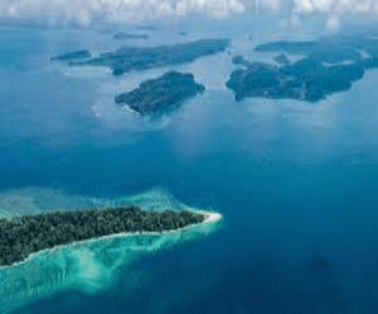The Andaman and Nicobar Islands (A&N Islands) play a critical role in India’s maritime strategy due to their geographic location and proximity to vital sea lanes. The growing maritime presence of the Chinese PLA Navy has further elevated the islands’ strategic value.
Key Strategic Highlights
- The islands are located 700 nautical miles (1,300 km) southeast of the Indian mainland.
- The Malacca Strait, the main waterway that connects the Indian Ocean to the Pacific, is less than a day’s steaming from Port Blair.
- Sabang in Indonesia is 90 nautical miles southeast of Indira Point (on Great Nicobar island), and Coco Island (Myanmar) is barely 18 nautical miles from the northernmost tip of the Andamans.
- The mouth of the Kra Canal (to be built by Thailand to connect the Gulf of Thailand with the Andaman Sea) would be located roughly 350 nautical miles east of Port Blair.
- The islands share four of India’s international maritime boundaries with Myanmar, Thailand, Indonesia and Bangladesh.
- They also give India substantial ocean space under the United Nations Conference on the Laws of the Sea (UNCLOS) in terms of exclusive economic zone and continental shelf.
Major Strategic & Development Challenges
- A serious challenge arises from a build-up of Chinese maritime forces at the eastern choke points of the Indo-Pacific
- Namely the Malacca (between Sumatra and the Malay peninsula), Sunda (between Java and Sumatra), Lombok (between Bali and Lombok), and Ombai-Wetar (off East Timor) straits.
- Political decision-makers have very recently realised how vitally important the islands are. This is because of the PLA Navy’s unprecedented expansion.
- The distance from the mainland and difficulties of developing infrastructure have been used as an excuse to delay and stall various projects.
- Regulations on the conservation of forests and native tribes have complicated issues of land acquisition.
- The development of islands and strategic infrastructure is a multi-dimensional project involving several ministries, departments, and agencies
- The conflict between a long-term strategic vision and immediate political gains has often tilted in favour of the latter.
Security and Defense Imperatives
- The security of all 836 islands, both inhabited and uninhabited, must be ensured against attempts at their occupation or use by entities engaged in unlawful activities.
- A strong element of deterrence must be ensured against any naval misadventure from the East.
- Infrastructure must be built on the southern group of islands that is strategically located vis-à-vis the main shipping lane from the Indian Ocean to South East Asia.
- Improved transportation will help to create and sustain the tourism potential of the islands.
- The islands’ dependence on mainland support, whether in respect of foodstuffs or relevant local industries that support maintenance, repair, and other services, must be reduced to the extent possible.
- The military must increase forces and deploy the appropriate assets at the Andaman Nicobar Command (ANC) to maintain island security. This includes basing surveillance and fighter aircraft there, as well as conducting frequent detachments
Geography of Andaman and Nicobar Islands (A&N Islands)
- The Andaman Islands are the extension of the submerged ArakanYoma Tertiary Mountain range of Myanmar and the Nicobars are the continuation of the Mentawai Islands to the south and southeast of Sumatra.
- These two island groups situated in the Bay of Bengal
- Andamans are separated from Nicobar by a 10-degree channel (10-degree latitude).
- South Andaman and Little Andaman are separated by Duncan Passage.
- The Grand Channel is between the Great Nicobar islands and the Sumatra islands of Indonesia.
- The Coco Strait is between the North Andaman islands and the Coco Islands of Myanmar.
- Port Blair, located in South Andaman is the administrative capital of the Andaman and Nicobar Islands.
- The southernmost point of India is The Indira Point, (formerly known as Pygmalion Point and Parsons Point) which is the southern point of the Great Nicobar Islands.
- The highest peak of the Andaman and Nicobar Islands is Saddle Peak, located in the North Andaman.
Historical Significance of Andaman and Nicobar Islands (A&N Islands)
- British established a penal colony in the Andaman and Nicobar (A&N) islands, where many Indian revolutionaries and freedom fighters were incarcerated for life in the aftermath of the 1857 War of Independence
- In 1942 the Andaman and Nicobar islands were occupied by the Japanese as a prospective springboard for the invasion of India after their occupation of Singapore
- In 1943 the islands became the first part of India to be ‘liberated‘ from British rule, when Netaji Subhas Chandra Bose visited Port Blair and hoisted the INA tricolour.
- British reoccupied the Andaman and Nicobar Islands after the Japanese surrender in 1945
- After the Japanese surrender in 1945, the British reoccupied the islands. On the eve of Independence islands were given to India.
- From Independence till 1962, the island was subjected to benign neglect by New Delhi due to the attachment of dark symbolism of Kalapani coupled with the remoteness of the islands.
- However, in 1962, the government sanctioned a detachment of 150 sailors to form a ‘naval garrison’ when the Indian Navy (IN) raised an alarm about the reported sighting of a Chinese submarine.
- In 2001 India’s first joint and Unified operational command– the Andaman Nicobar Command (ANC) was established in Port Blair after the post-Kargil War security review
Government Initiatives For The Andaman and Nicobar Islands (A&N Islands)
- NITI Aayog’s Project for Great Nicobar- It entails development of an international container transhipment terminal, an airport, a power plant, and a township.
- NITI Aayog’s Proposal for Little Andaman- The plan calls for the development of a new greenfield coastal city to compete with Singapore and Hong Kong.
- Modernisation of Defence Infrastructure- Modern Hangar and Dispersal system at INS Utkrosh in Port Blair. Naval Communication Network (NCN) Centres at INS Kohassa, INS Baaz and INS Kardi, designed to further augment the communication and operational capability of the Andaman and Nicobar Command.
- Submarine cable connectivity to Andaman & Nicobar Islands (CANI)- The submarine Optical Fibre Cable (OFC) will connect Andaman &Nicobar Islands to the mainland
Conclusion
The Andaman and Nicobar Islands are India’s eastern gateway to the Indo-Pacific region, offering unmatched strategic leverage. Strengthening their defense, governance, and development ecosystem is vital not only for national security but also for regional maritime dominance and economic growth.
To Download Monthly Current Affairs PDF Click here
Click here to get a free demo
Discover all about CLAT Exam



